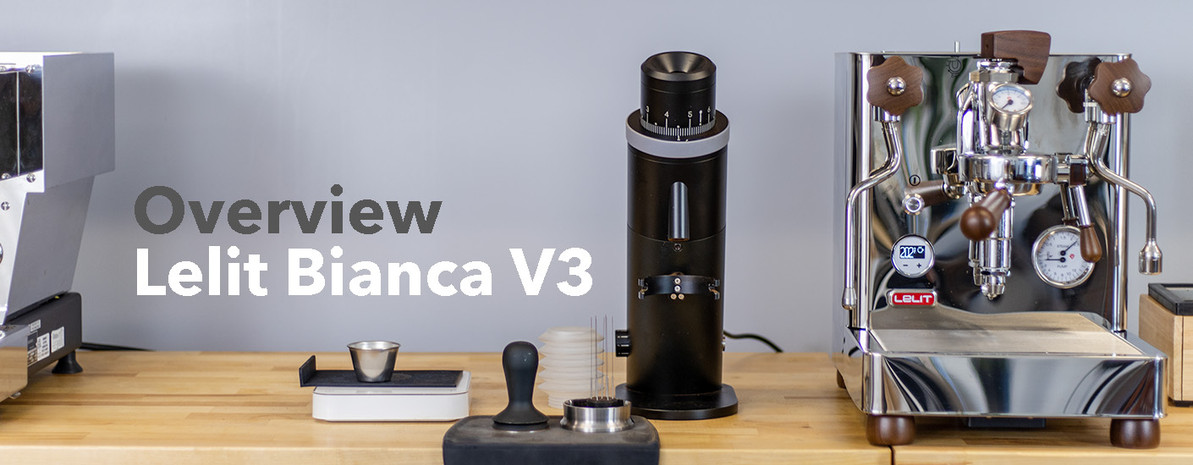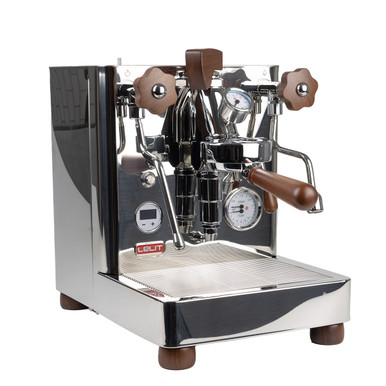Video Overview | Lelit Bianca V3 Home Espresso Machine
Transcript
I'm Ryan from Prima and this is the Lelit Bianca V3 home espresso machine. In recent years, the Bianca has become one of the top picks for serious home espresso enthusiasts because of its innovative design and flexible features that allow for more variable control than any E 61 style machine before it. Now in its third iteration the Bianca V3 brings even more variable options and supplements its original features with programmable automation, making it really easy for everyone in the house to use.
At heart, the Bianca is an E 61 group head design featuring a saturated group head that circulates water from the coffee boiler for temperature stability and a mechanical lever to start and stop the shot. The Bianca is designed to be incredibly compact for a machine of its caliber measuring only 15 and three quarters inch tall, 11.4 inches wide, and 19.1 inches deep with the reservoir on the back. In addition to direct plumb capability the Bianca features a modular water reservoir that can be moved to any one of three sides of the machine making it ideal for a tight kitchen spaces. And it also features a cool touch steam wand, a hot water dispenser for tea and Americanos, and a removable drip tray with a one liter capacity when not plumbed in. This particular variation of the Bianca includes walnut handles and actuators and polished stainless throughout the body. There is also a white and black variation of the machine that I don't have with me here today. On the front panel is a back lit display with control buttons that Lelit calls the LCC or Lelit Control Center. Here you can see your shot timer and adjust all sorts of different parameters which we'll get to in just a minute. Inside the Bianca is a dual boiler system with one 1.5 liter boiler dedicated to steaming and another 800 milliliter boiler dedicated to coffee brewing. This allows simultaneous brewing and steaming and also independent PID temperature and pressure control over each boiler to dial it in exactly the way you like.
Probably the most important feature of the Bianca is its flow control paddle located above the group head, which opens and closes a needle valve for variable water flow throughout a shot cycle. When you pull the lever and start a shot in manual mode the internal rotary pump will kick on at full pressure which is around nine bars outta the box. But the actual pressure reaching the coffee grounds depends on the rate of water flow into the group and that's where this paddle comes in. There are lots of possibilities to explore with flow profiling, but is most often used to introduce water at a low pressure in the initial stages allowing a gentle and more even saturation of the coffee while helping to mitigate channeling. Channeling happens when water dramatically favors some flow paths through the coffee more than others resulting in an uneven extraction and overall bad tasting coffee. When used correctly, flow profiling machines offer an extra measure of forgiveness with channeling issues and also allow the user to grind finer to more easily hit higher extractions. The flow control paddle can also be manipulated at other stages in the shot cycle especially near the end to get some different flavors out of your espresso.
So now that we've talked a lot about what the Bianca is let's get into the LCC and talk about the new features that Lelit has introduced in the V3 model. Low flow start is the first parameter of the Bianca V3's new automated low flow mode. When low flow mode is engaged the Bianca's rotary pump will begin the shot cycle at full pump power but a special solenoid valve in the group's water output hydraulic system opens only part way to produce about four to five bars of pressure depending on your grind size and as long as the flow control paddles all the way open. So the flow and pressure in low flow mode is still dependent on where you have the paddle set just like it is in manual mode. So here's how it works. If we set low flow start to 10 seconds, the machine will automatically begin the first 10 seconds of the shot cycle at low flow before transitioning into full pressure for the duration of the shot. Low flow final is the next parameter of low flow mode which allows us to determine at what time in the brew cycle the machine drops back down to low flow. With both low flow start and low flow final engaged the machine begins and ends with low pressure and flow. Low flow in the final stage of the shot will continue indefinitely since the Bianca features a mechanically operated group so you are still responsible at the end of the shot to shut that lever off at the appropriate time. Low flow mode can be combined with an automatic pre-infusion where the machine begins the shot by filling the group for a programmed time. Then this engages the pump for a programmed time and allows that water to dwell and saturate the coffee under no pressure. When both pre-infusion and low flow mode are turned on the time values selected for pre-infusion are subtracted from the low flow start time. Now that sounds a little confusing but here's how that works. Let's say I have low flow start programmed for 16 seconds. If I also engage pre-infusion and set it to four seconds on, four seconds off, the machine will follow the pre-infusion cycle with eight seconds of low flow mode before transitioning into full pressure, a total of 16 seconds. And of course, pre-infusion can also be engaged without low flow mode following it and low flow mode can be engaged without pre-infusion preceding it allowing you a ton of options. Ultimately, these automated features are there to allow others in the household to get the benefits of the Bianca features without relying on the intuition required for manual mode or if you want to use the same recipe every day. This automation allows the user to steam milk simultaneously while the Bianca goes through all of the complicated steps for you, streamlining the drink making process. Next, let's talk about brew temp offset, which is also new to the V3. Brew temp offset can be set between negative 45 and plus 45 degrees Fahrenheit. The intent of this feature is to set how much temperature loss can occur before the group head heating element will turn on again and begin reheating. Negative 10, for example, should basically keep the element off during the whole extraction and positive 10 should keep it heating and increasing at all times. We set our Bianca to 202 degrees in the coffee boiler and then tested it three times with a Scace device, one set zero, negative 10, and plus 10. Here's what that looked like. Overall, you can see a pretty minimal difference between these. This is over the course of around 25 to 30 seconds and about 45 milliliters of water out through the Scase. We did find a few let it go for much longer like say 50, 60, 70, 80 seconds. The temperature would continue to climb up if you had a positive number and it would decline more if you had a negative number. But this just didn't seem to have a whole lot of effect within the scope of a 40 to 50 milliliters shot. In addition to these new features the Bianca LCC allows the user to set sleep and wake times and even disengage the steam boiler in eco-mode for espresso only use. Depending on how you use the machine those features may equate to a bit of a power savings over time. Included with the Bianca is a large box full of many useful accessories. It includes a double spouted walnut porta filter, a bottomless walnut porta filter, Lelit's 58 millimeter stainless steel tamper, an in-tank water softener, a single, double, and triple basket, a back flush blank disc, a two and four hole steam tip, a microfiber cleaning cloth, braided plumbing line, drip tray drain attachment, and finally a group head cleaning brush, all kinds of stuff. Overall, the Bianca V3 is a modern home espresso machine for the modern home espresso enthusiast packed with interesting features and variable controls but with the ability to be used simply and without complication when desired. Check out the Lelit Bianca V3 at primacoffee.com. Thanks for watching.




